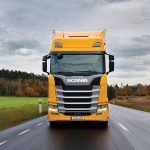Out with the old, in with the new?
Out with the old, in with the new?
The medium and heavy-duty commercial vehicle market is expected to register a compound annual growth rate of 5,1% between 2020 and 2025, says Mordor Intelligence, a global market research and consultancy firm based in India. What will be the driving force? And will there be any new developments?
In its report “Medium and Heavy Duty Commercial Vehicles Market – Growth, Trends, Covid-19 Impact and Forecasts (2021 – 2026)” Mordor Intelligence notes that some of the major factors driving growth are the expansion of industrial sectors within emerging markets, growing demand from the logistics industry and rising demand from the construction sector.
“The market is expected to witness growth in the coming years, owing to growing economies across both developing and developed countries,” it points out.
This is in line with the positive economic outlook brought about by various fiscal stimulus packages across the globe.
“Owing to consistent technological advancements and enactment of stringent emission norms, automakers (OEMs) are shifting their focus towards electric vehicles (as well),” says the report.
“Across the globe, some countries have banned old commercial vehicles from running on public roads to tackle the growing levels of vehicle emissions. Thus, the possibility of freight businesses, adopting new commercial vehicles that are eco-friendly, cost-effective and align with the emission standards, will increase at the global level during the forecast period.”
It adds that OEMs are continuing to invest in research and development (R&D) activities and plans to successfully develop and launch more electric commercial vehicles. “For instance, Renault Trucks, after ten years of experimentation with its all-electric truck, unveiled medium and heavy-duty electric vehicles in 2018 – namely Renault Trucks D Wide Z.E and Renault Trucks D Z.E – ideally suited for use in the cities of France.”
But the electrification of medium and heavy-duty commercial vehicles brings its own set of challenges, as noted by the US Department of Energy in its piece “Medium- and Heavy-Duty Vehicle Electrification, An Assessment of Technology and Knowledge Gaps”.
“Distinguishing aspects of electrification of commercial medium- and heavy-duty vehicles, versus electric passenger cars, and market success of electrified MHDVs will require development beyond merely scaling devices and designs from light-duty EVs for passenger travel.”
The report adds that while technological advancement in LDVs can often benefit the MHDV market, key differences result in R&D gaps, which are limiting the electrification of commercial vehicles.
“The life expectancy of an HD vehicle can exceed 1 million miles (more than 1,6 million kms), and the average age of commercial trucks on the road is about 14 years. These miles are also often over more demanding duty cycles. Therefore, many components and systems must be more durable than those intended for LD applications of about 15 years and 150 000 miles (more than 240 000 km).”
Another aspect is the increase in energy consumption of MHDVs. These vehicles will require much larger batteries to obtain the same range as their fossil-fuel burning counterparts. “Today’s MHDV plug-in electric vehicle batteries have as much as 660 kWh, while near future concepts may exceed1 200 kWh. It is expected that freight duty cycles will result in deeper battery discharges than in LDV experience, tending to shorten the useful life of the batteries.
“Faster charging rates may impact cycle life as well. Goals for battery cycle lifetimes and total cost of ownership (TCO) analyses should consider these effects. Fast-charging these batteries will require substantially more power compared to current extreme fast-charging for LDVs (350 kW) at much greater than a megawatt. This presents new challenges and requires much higher power chargers, connectors and infrastructure than are currently considered for LDVs.”
There are also other challenges, as Jim Park, a journalist at Trucknews.com – trucking news from the editors of the Canadian magazine Today’s Trucking – notes in his article “Are electric trucks viable without government support?”
“The business case for medium- and heavy-duty electric trucks just doesn’t work, and there’s little if any public infrastructure in place to support the growth of the commercial electric fleet,” he writes. “If we are to see broad uptake of zero-emission transportation, manufacturers and consumers will need massive government support, possibly market intervention, and a serious examination of the regulations that apply to electric trucks.
“That’s the view of Sean Waters, Daimler Trucks North America’s vice-president of product compliance and regulatory affairs,” he says.
“People don’t buy our trucks because they want to,” said Waters, the keynote speaker at last year’s Green Truck Summit. “People buy our trucks because they have to. These aren’t toys. These are pieces of capital equipment, and capital goes where it can make money. If you found that an electric vehicle costs more than a diesel one and you can’t make that money back, you’re not going to buy it.”
Mark Wagner, product planning manager at the American-based truck manufacturer Kenworth, adds that with the current state of the technology, it’s hard to get a return on investment, “even for the green image”.
“With a purchase price [of an electric truck] two or three times higher than a diesel truck, along with the required investment in infrastructure, any energy or fuel savings is not enough to overcome the initial cost. That’s why local or federal incentives will be required to launch most fleets down the path to a zero-emissions vehicle.”
It will be interesting to see how the industry grows globally in the years ahead, and if governments will step up to meet the challenge.
SUCCESS FOR SOUTH AFRICAN
Mercedes-Benz Vans USA announced the appointment of South African Nicolette Lambrechts to the position of vice president and managing director of sales and marketing, effective May 1, 2021.

She will lead all van business operations including the sales, marketing along with service and parts for Mercedes-Benz Vans in the United States. Lambrechts succeeds Robert Veit, who will take over as managing director of Mercedes-Benz Vans UK.
“We are very pleased that Nicolette Lambrechts will take over the position as head of sales and marketing of Mercedes-Benz Vans USA. The United States is the largest market for our Sprinter vans, after Germany. With her many years of international experience in the field of sales and marketing, we’re confident she will further develop our van business,” says Marcus Breitschwerdt, executive vice president Mercedes-Benz AG and head of Mercedes-Benz Vans.
“I would like to thank Robert Veit for an outstanding job overseeing the US market. I am convinced that his wealth of experience and leadership skills will help to continue to drive our business ambition forward as managing director of Mercedes-Benz Vans UK.”
Lambrechts joined the Mercedes-Benz USA Vans team in October 2019 as the general manager for Mercedes-Benz Vans Sales. She built a talented, successful and diverse sales team and implemented new business processes and strategies across the entire value chain, which enabled the team to achieve profitable sales growth within the US market.
She joined Mercedes-Benz South Africa in 2001 as a graduate trainee. In 2002, she took over the position as sales planner for ChryslerJeep and was promoted in 2004 to distribution and logistics manager for commercial vehicles. Between 2008 and 2014, she held management roles as the national sales manager and brand manager for Mercedes-Benz Vans in South Africa.
In 2014, she was promoted to managing director of the Vans Division for Mercedes-Benz South Africa, where she led her team to consistently surpass targets and worked to build a strong relationship with the local dealer network. In 2017, she took over the role as managing director of Mercedes-Benz Vans Canada.
Published by
Focus on Transport
focusmagsa



 FUSO: Driving the Future of Mobile Healthc
FUSO: Driving the Future of Mobile Healthc



 New Electric Van Range Unveiled!
New Electric Van Range Unveiled!  A brand
A brand




 Wondering about the maximum legal load for a
Wondering about the maximum legal load for a 
 The MAN hTGX powered by a hydrogen combus
The MAN hTGX powered by a hydrogen combus


 Exciting News for South African Operators
Exciting News for South African Operators







